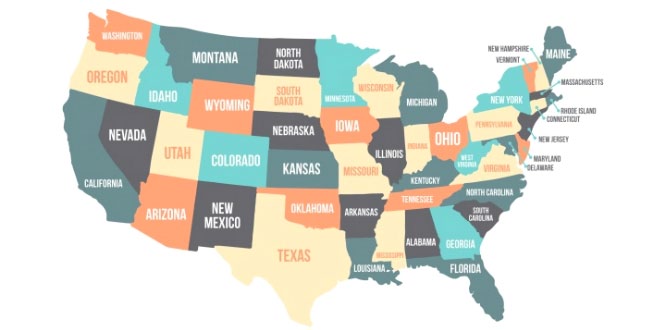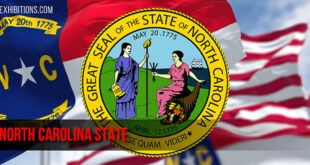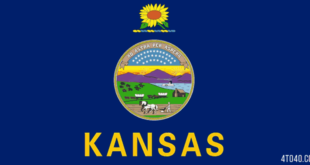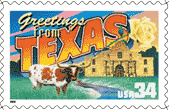
Texas State shows the influence of both the Indians and the Spanish, French, and other European explorers and missionaries. In 1820, Moses and Stephen F. Austin started the Anglo-American colonization that culminated in the organization of a provisional government at San Felipe on Nov. 3, 1835, and in independence from Mexico on Mar. 2, 1836. After almost ten years as an independent republic, Texas became a U.S. state on Dec. 29, 1845.
The modern economic development of Texas State started in January 1901 with the eruption of an oil well drilled at Spindletop, near Beaumont. The rapid discovery of oil in various other parts of the state led to a boom that has never really stopped. The economy of Texas State has become highly diversified, and its population has more than quadrupled during this century.
Texas State: Land & Resources
Topography and Soils
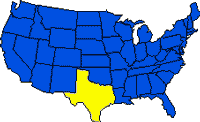 Four major physiographic subdivisions of North America are found in Texas: the Gulf Coastal Plain in the east and southeast, the North Central Plains running north to southeastward in the center of the state, the Great High Plains in the northwest, and the Trans-Pecos Mountains to the extreme west and southwest. The topography of Texas rises gradually from east to west, reaching its highest point in Guadalupe Peak (2,667 m/8,749 ft) in the Trans-Pecos.
Four major physiographic subdivisions of North America are found in Texas: the Gulf Coastal Plain in the east and southeast, the North Central Plains running north to southeastward in the center of the state, the Great High Plains in the northwest, and the Trans-Pecos Mountains to the extreme west and southwest. The topography of Texas rises gradually from east to west, reaching its highest point in Guadalupe Peak (2,667 m/8,749 ft) in the Trans-Pecos.
The Gulf Coastal Plain, extending about 80 to 100 km (50 to 60 mi) inland from the Gulf of Mexico, from sea level to an altitude of about 150 m (500 ft), has a rolling-to-hilly surface. Its western part consists of a fertile belt of land of irregular width known as the Blackland Prairie.
Inland from the Coastal Plain, the North Central Plains of Texas are the southern extension of the GREAT PLAINS and reach southwestward across the entire state to the Rio Grande. The plains’ southern portion is known as the Edwards Plateau. The border of the North Central Plains on the west is the Staked Plain, or Llano Estacado in Spanish. It consists of a flat-topped tableland with an elevation of about 1,200 m (4,000 ft). Lying between Mexico and New Mexico, the barren Trans-Pecos region in southwestern Texas alternates between rolling hills in the Pecos River valley and the isolated high ridges of the Guadalupe and Davis mountains.
Texas is divided into 14 land resource areas that have similar or related soils, vegetation, topography, and climate. The soils vary greatly in depth from one region to another and show different physical properties; all need fertilizing, however, and some need irrigating to make them productive.
Texas has relatively few natural lakes but hundreds of artificial ones. These were developed to provide hydroelectricity, to store water, or to irrigate farmland. Among the largest are Lake Texoma (partly in Oklahoma) on the Red River, the Falcon and Amistad reservoirs on the Rio Grande, Sam Rayburn Reservoir on the Angelina River in eastern Texas, Lake Texarkana on the Sulphur River, Toledo Bend Reservoir on the Sabine, Lake Travis on the Colorado, and Lake Livingston on the Trinity River north of Houston.
Climate
The climates of Texas range from the hot subhumid found in the Rio Grande valley to the cold semiarid of the northern part of the Panhandle, and from the warm humid in the east to the arid of the Trans-Pecos. Rainfall varies from 1,400 mm (55 in) in the east to less than 250 mm (10 in) in the west. The average number of days with some precipitation ranges from 44 in El Paso to 110 in Houston. Drought can be a serious problem, especially in the Great High Plains, where an average of seven droughts occur in a 10-year period. Temperatures, too, vary greatly, ranging from 49 deg C (120 deg F) to -31 deg C (-23 deg F). Each year about 100 tornadoes occur, most frequently in the Red River valley.
Tourism
Texas attracts millions of out-of-state visitors annually; its tourist-related businesses compete with California and Florida for the U.S. travel market. Many visitors explore Dallas, San Antonio, Houston, Fort Worth, El Paso, Austin, and other cities. Sites of special interest range from Nacogdoches in East Texas, one of the state’s oldest cities, to the Lyndon B. Johnson Space Center near Houston. Texas’s two national parks, BIG BEND and Guadalupe Mountains, are also popular, as are the numerous and varied state recreation areas. Hunting and fishing are popular pastimes for visitors and Texans alike, as are professional and college sports events.
Texas State: History
Evidence of a meeting in eastern Texas between Middle American prehistoric cultures and temple MOUND BUILDERS from the eastern part of what is now the United States has been discovered in an Indian mound on the Neches River, and many tribal groups–including the APACHE, CADDO, and Comanche–inhabited what is now Texas.
Conquest and Colonization
The first European explorers were the Spaniards Alvar Nunez CABEZA DE VACA (1528) and Francisco CORONADO (1541). Other Spanish expeditions followed during the next century, and in 1682, Ysleta, near El Paso, became the first European settlement in Texas. Three years later Robert Cavalier, sieur de LA SALLE, brought the second flag (French) to Texas. He landed at the head of Lavaca Bay and established Fort Saint Louis.
La Salle was killed by one of his own men in 1687, and his fort was destroyed by disease and the Indians. About 1714, however, the Spanish felt threatened by another Frenchman, the explorer and trader Louis Juchereau de Saint Denis. Although he claimed that his intention was simply to establish trade, he was arrested and sent to Mexico City. The Spanish then redoubled their efforts to settle Texas, and by the middle of the 18th century they had mounted more than 100 expeditions to the area.
American Interest in Texas
The sale (1803) of Louisiana to the United States increased interest in Texas from the east. Augustus Magee, a U.S. army officer in Louisiana, befriended the Mexican patriot Bernardo Gutierrez, who had been fighting for his country’s independence from Spain. Together they led an expedition into Texas and captured Nacogdoches, Goliad, and San Antonio before Magee died mysteriously in Goliad.
In 1819, Dr. James Long of Natchez, Miss., led another expedition to Texas, hoping to make the region an independent state. He captured Nacogdoches but his forces were soon defeated. A year later, Moses Austin visited San Antonio and sought permission to settle Americans in Texas. Upon returning to Missouri, his dying request was that his son, Stephen AUSTIN, carry out his plans, which the Spanish had approved.
In 1821 the white population of Texas was 7,000, with Goliad, San Antonio, and Nacogdoches the only towns of any size. During this period Mexico secured its independence from Spain, and, in 1823, Stephen Austin went to Mexico City to seek confirmation of his father’s grant. A new law required that agents introduce at least 200 families of colonists, so Austin made an agreement with the Mexican governor to settle 300 American families. Colonization was so successful, however, that by 1836 the population of Texas was 50,000.
Revolution and Republic
Differences in language, culture, and religion soon led to difficulties between the new Anglo-American settlers and the Mexican government. Because of the great distance between Texas and Mexico City, cultural and commercial ties grew stronger with the United States, and some settlers hoped that U.S. boundaries would be extended to include Texas.
In 1830 the Mexican congress enacted a law to limit immigration to Texas. But this only increased dissatisfaction, for neither the Mexican national constitution nor the constitution of 1827 for the state of Coahuila-Texas granted rights that Anglo-Americans considered inalienable, such as trial by jury and the right of bail. Most settlers also found unacceptable the requirement that they become Roman Catholics because most of them were Protestants.
War broke out between the American settlers and the Mexican government in 1835, and the Texans won the first battle at Gonzales on Oct. 2, 1835. The same year the Texans captured San Antonio after a devastating siege; a provisional government was set up on Mar. 2, 1836, and Sam HOUSTON was named commander in chief of the Texas armies, Stephen Austin having gone to Washington to solicit aid from the U.S. government.
In February and March 1836 one of the most heroic battles in history occurred at the Alamo. The besieged Texas forces commanded by William B. TRAVIS had been reduced to 157. He appealed for help, and about 30 additional men from Gonzales broke through the lines of the Mexican general, Antonio SANTA ANNA. The 187 defenders, commanded by Travis, James BOWIE, and Davy CROCKETT, then held the Alamo for another 5 days before it fell. March also saw a massacre at Goliad, in which the outnumbered Texans, having surrendered after a battle on Coleto Creek, returned to Goliad only to be killed on the orders of Santa Anna.
Despite reverses, the Texans declared their independence in a great spirit of resistance, and on Mar. 2, 1836, David Burnet was named provisional president. Thinking the war was over, Santa Anna moved eastward with his army. Sam Houston’s troops–half the number of the Mexicans–occupied a position at the junction of the San Jacinto River and Buffalo Bayou, opposite Santa Anna’s camp. On the afternoon of April 21 the Texans attacked while Santa Anna was having his siesta. Their battle cry was “Remember the Alamo; Remember Goliad.” Santa Anna fled but was taken the next day and held prisoner for 6 months.
Statehood and the Mexican War
The Texas republic, whose independence had been recognized by the United States, Great Britain, France, Holland, and Belgium, was soon struggling with Indian wars, raids by Mexican forces, and financial problems. In September 1836, Texans voted for annexation by the United States; approval by the U.S. Congress was delayed until 1845, however, because of the northern states’ opposition to the extension of slavery. On Dec. 29, 1845, the U.S. Congress accepted the Texas state constitution, and Texas became the 28th state, with legal slavery.
The MEXICAN WAR between the United States and Mexico followed within a few months of Texas’ entry into the union. The U.S. victory in that war established the Rio Grande as the border between Mexico and the United States. Texas, however, claimed all the territory from the mouth of the Rio Grande to its source in southern Colorado, a claim vigorously opposed by those who wished to exclude slavery from the territories newly acquired from Mexico. In 1850, as part of the COMPROMISE OF 1850, Texas relinquished its claim to half of what today is New Mexico and portions of Colorado, Wyoming, Oklahoma, and Kansas in exchange for the sum of $10 million.
Texas withdrew from the Union on Feb. 1, 1861. Little fighting took place on Texas soil during the Civil War, the most important engagements being the capture and recapture of Galveston, the principal port. A battle took place at Palmito Ranch near Brownsville, after General Lee had already surrendered at Appomattox.
Military rule following the Civil War was short-lived, but the state was inundated with CARPETBAGGERS. On Mar. 30, 1870, Texas was readmitted to the Union after ratifying the 13th, 14th, and 15th amendments to the U.S. Constitution. Following the Civil War cattle ranching became increasingly important to the economy, and vast herds were driven to the railroad in Kansas over the CHISHOLM TRAIL.
Modern Era
When the 20th century began, about 3 million people lived in Texas, and agriculture dominated the economy. Then in 1901, Spindletop, the state’s first great oil gusher, was discovered. Soon oil was found in virtually every part of the state, and the great east Texas oil field, discovered in 1930, helped lessen the impact of the Depression.
Racial segregation was a continuing issue throughout most of the 1950s and ’60s, but by 1966, Texas ranked first among southern states in integrating its schools. The poll tax was abolished by court action in 1966. Another court decision led to redistricting the Texas legislature to conform to the Supreme Court policy of one person, one vote.
Politically prominent Texans in the 1960s, 70s, 80s, and 90s included President Lyndon B. JOHNSON, Congresswoman Barbara JORDAN, President George BUSH, and Governor Ann Richards. In 1987 the Texas legislature approved a landmark $5.7 billion tax increase. Some critics complained that it did not completely correct Texas’s past reliance on oil-industry taxes at a time when the state was becoming more dependent on service industries.
Texas State: Land
- Area: 695,674 sq km (268,601 sq mi); rank: 2d.
- Capital: Austin (1990 census, 465,622).
- Largest city: Houston (1990 census, 1,630,553).
- Counties: 254.
- Elevations: highest–2,667 m (8,749 ft), at Guadalupe Peak; lowest–sea level, at the Gulf of Mexico.
 Kids Portal For Parents India Kids Network
Kids Portal For Parents India Kids Network
